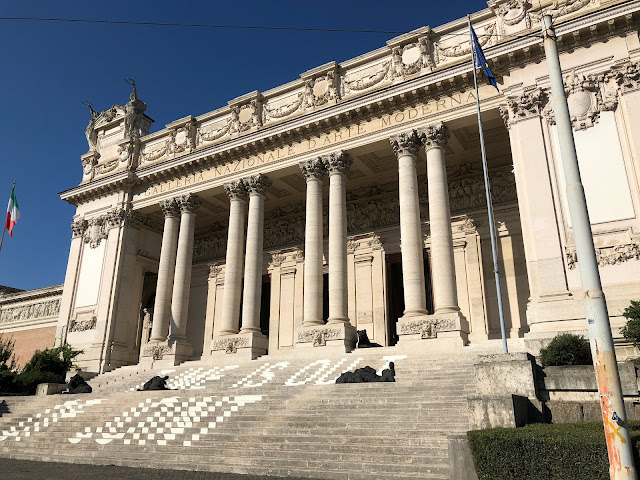【ローマ】国立近代美術館 未来派 Roma - National Gallery of Modern and Contemporary Art & Futurismo
ボルゲーゼ美術館は広大なボルゲーゼ公園の東の端の方に建っているが、逆になる西側の区画に国立近代美術館がある。
ボルゲーゼ美術館には、カラヴァッジオやベルニーニの作品があるので多くの人が訪れるが、この国立近代美術館を訪れる人はそれほど多くはない。
しかし、この美術館にはイタリアを中心にしたヨーロッパの近代美術の作品が数多く展示されていて、足を伸ばす価値は十分ある。
The Borghese Gallery is located on the eastern edge of the vast Villa Borghese Park, but on the opposite west side is the National Museum of Modern Art.
The Borghese Gallery is visited by many because of the works of Caravaggio and Bernini, but not so many.
However, there are many works of modern European art, mainly Italy, in this museum, and it is well worth the trip.
今回のイタリアへの旅では、日本ではあまり目にする機会のない、未来派の作品を数多く観てみたいと考えていた。
未来派は20世紀初頭にイタリアで始まった芸術運動で、絵画や彫刻のみならず、文学や音楽、演劇などの様々な分野でユニークな活動が行われた。
しかし戦争を賛美する思想や、イタリアのムッソリーニとの関係などもあってか、日本においてはあまり注目を浴びていない。
だからこそ、本番のイタリアで、未来派の作品を目にできることをとても楽しみにしていた。
On this trip to Italy, I wanted to see a lot of Futurist works that I rarely see in Japan.
Futurism is an art movement that began in Italy in the early 20th century, with unique activities in various fields such as literature, music, and theater, as well as painting and sculpture.
However, due to the idea of praising the war and the relationship with Mussolini of Italy, it has not received much attention in Japan.
That's why I was really looking forward to seeing Futurist works in production Italy.
ウンベルト・ボッチョーニは、未来派の主要なメンバーで多くの絵画や彫刻作品を残した。
しかし、第一次世界大戦が始まると進んで参戦し、1918年8月17日に落馬して馬に踏みつけられて命を落としてしまった。
このローマの国立近代美術館には、絵画や彫刻など様々なボッチョーニの作品が展示されていた。
Umberto Boccioni was a major member of the Futurism and left behind many paintings and sculptures.
However, he was willing to participate in the war when World War I began, and on August 17, 1918, he fell and was trampled by a horse and died.
At the National Museum of Modern Art in Rome, various Boccioni works such as paintings and sculptures were exhibited.
ジャコモ・バッラは、1871年にトリノで生まれ、1900年ごろにパリを訪れて芸術家として大きな刺激を受けた。
バッラは未来派の中心的なコンセプトである、動きやスピードを表現した作品を数多く制作したが、『抽象的な速度』(1913年)というこの作品は、バッラのみならず、未来派を代表する作品の一つになっている。
マルセル・デュシャンの有名な作品『階段を降りる裸体No.2』は、1912年のアンデパンダンテ展に展示される予定だったが、キュビストたちからあまりにそのコンセプトが未来派過ぎるという理由で拒否された、という有名なエピソードが残っている。
このバッラの作品に見られるように、20世紀初頭には鉄道、自動車などが社会に普及し始めて、スピードというテーマは未来派を象徴するテーマだった。
Giacomo Balla was born in Turin in 1871 and visited Paris around 1900, which inspired him as an artist.
Balla produced many works expressing movement and speed, which is the central concept of Futurism, but this work called "Abstract Speed" (1913) represents not only Balla but also Futurists. It is one of the works.
Marcel Duchamp's famous work "Nude Descending the Stairs No. 2" was scheduled to be exhibited at the Salon des Indépendante in 1912, but was rejected by the Cubists because the concept was too futurist. The famous episode remains.
As seen in Balla's work, railroads and automobiles began to spread in society at the beginning of the 20th century, and the theme of speed was a symbol of Futurism.
バッラは、1910年代に抽象的な作品を多く描いており、モンドリアンやカンディンスキーらとともに、最も早く抽象絵画を描き始めた画家でもある。
1915年に描かれた『戦争の落とし穴』という作品は、そうした抽象画の一つだが、一見すると岡本太郎の作品のようにも見える。
Balla painted many abstract works in the 1910s, and along with Mondrian and Kandinsky, was one of the earliest painters to paint abstract paintings.
At first glance, this work looks like the work of Taro Okamoto.
バッラは、未来派の中ではボッチョーニやカッラなどよりは年長にあたり、マリネッティの1909年の未来派宣言以前から、画家としてある程度知られていた。
1905年に描かれたこの作品では、後期印象派の影響だろうか、様々な色彩を使って、屋外の光と、室内に注ぎ込む光を、表現しようとしている。
Balla, older than Boccioni and Carra in Futurism, was known to some extent as a painter even before Marinetti's 1909 Manifesto of Futurism.
Painted in 1905, perhaps influenced by Post-Impressionism, he uses a variety of colors to express both the outdoor light and the light that pours into the room.










コメント
コメントを投稿